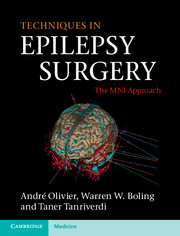Book contents
- Frontmatter
- Contents
- Acknowledgment
- Preface
- 1 History of epilepsy surgery
- 2 The search for the epileptic focus: investigation of the surgical candidate
- 3 Surgical anatomy
- 4 Neuronavigation and preoperative brain mapping
- 5 Stereoelectroencephalography (stereotactic intracranial recording)
- 6 Anesthesia and awake procedure
- 7 Peroperative brain mapping
- 8 Endopial resection (intervascular endopial gyral emptying)
- 9 Surgery of temporal lobe epilepsy: cortico-amygdalohippocampectomy
- 10 Surgery of temporal lobe epilepsy: transcortical selective amygdalohippocampectomy
- 11 Surgery of central area epilepsy
- 12 Surgery of frontal lobe epilepsy
- 13 Surgery of parietal lobe epilepsy
- 14 Surgery of insular lobe epilepsy
- 15 Surgery of occipital lobe epilepsy
- 16 Hemispherectomy
- 17 Callosotomy
- 18 Epilepsy and brain tumors
- 19 Surgical treatment of cortical dysplasias
- 20 Reoperations in failed epilepsy surgery
- 21 Alternative procedures in surgery for epilepsy
- 22 Complications of epilepsy surgery
- 23 Quality of life after epilepsy surgery
- Index
- References
17 - Callosotomy
Published online by Cambridge University Press: 05 October 2012
- Frontmatter
- Contents
- Acknowledgment
- Preface
- 1 History of epilepsy surgery
- 2 The search for the epileptic focus: investigation of the surgical candidate
- 3 Surgical anatomy
- 4 Neuronavigation and preoperative brain mapping
- 5 Stereoelectroencephalography (stereotactic intracranial recording)
- 6 Anesthesia and awake procedure
- 7 Peroperative brain mapping
- 8 Endopial resection (intervascular endopial gyral emptying)
- 9 Surgery of temporal lobe epilepsy: cortico-amygdalohippocampectomy
- 10 Surgery of temporal lobe epilepsy: transcortical selective amygdalohippocampectomy
- 11 Surgery of central area epilepsy
- 12 Surgery of frontal lobe epilepsy
- 13 Surgery of parietal lobe epilepsy
- 14 Surgery of insular lobe epilepsy
- 15 Surgery of occipital lobe epilepsy
- 16 Hemispherectomy
- 17 Callosotomy
- 18 Epilepsy and brain tumors
- 19 Surgical treatment of cortical dysplasias
- 20 Reoperations in failed epilepsy surgery
- 21 Alternative procedures in surgery for epilepsy
- 22 Complications of epilepsy surgery
- 23 Quality of life after epilepsy surgery
- Index
- References
Summary
Introduction and historical perspective
There has been a considerable resurgence of interest in the procedure of callosotomy for the surgical treatment of some intractable epilepsies, but this interest seems to have again waned over the last decade. Better-defined indications, the promise of newer generation antiepileptics, and newer palliative treatments such as vagal nerve stimulation are factors that have led to a reduction in the number of callosotomies being performed in most centers. Furthermore, although the efficacy of this procedure to reduce certain debilitating seizures has been questioned, it has been proven to be effective if well-defined indications are observed.
Callosotomy was first used in the human by Van Wagenen and Herren in 1940 with encouraging results, although it did not become an accepted mode of surgical treatment until much later. Bogen reintroduced callosal section in the early 1960s but again in spite of its demonstrated effectiveness, the procedure did not gain wide popularity. The explanation for this course of events was likely due to the fact that the early modalities of callosotomy were not restricted to the section of the corpus callosum proper but rather included most if not all of the forebrain commissures i.e. the corpus callosum in its entirety, the anterior commissure and at times the massa intermedia of the thalamus. These divisions resulted in high morbidity procedures at a time when technical facilities were not available. We owe to Wilson the introduction of microsurgical techniques to perform callosotomy in selected cases of intractable epilepsies. Wilson's efforts were in large part responsible for the resurgence of interest in callosotomy as a surgical modality in the late 1970s.
- Type
- Chapter
- Information
- Techniques in Epilepsy SurgeryThe MNI Approach, pp. 201 - 215Publisher: Cambridge University PressPrint publication year: 2012
References
- 1
- Cited by



